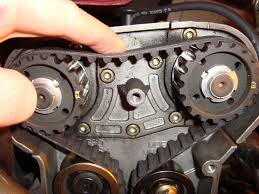
Timing Belt Replacement
Timing Belt Replacement means realizing that a timing belt is a very critical engine component. On most vehicles, a broken timing belt means you'll be buying a new engine!
A timing belt, timing chain or cam belt is a part of an internal combustion engine that synchronizes the rotation of the crankshaft and the camshaft so that the engine's valves open and close at the proper times during each cylinder's intake and exhaust strokes. Many car owners may wonder how often to replace a timing belt. The old rule was every 60,000 miles but as technology improves, many manufacturers now recommend intervals up to 100,000 miles. If your vehicle has anywhere near that mileage and you've never replaced your timing belt, you're on borrowed time! To be safe you should check what the vehicle's manufacturer recommends and stay within that mileage.
Common symptoms that might indicate that your timing belt is wearing out or has broken are:
- Ticking noise coming from the engine
- Engine won't turn over
- Engine misfires
- Oil leaking from front of the motor
Keep in mind:
- When replacing a timing belt, we suggest you also replace the water pump, tensioner, and pulleys.
- If the pulleys and tensioners fail after only replacing the belt, this can cause valve or piston damage and lead to more expensive repairs.
- We will only replace the water pump if it is driven by the timing belt (true for most cars).
Not all vehicles have a timing belt, some have a chain which usually doesn't require regular replacement. DRIVE AutoCare will be glad to review your vehicle manufacturer's recommended service and tell you if you have a timing belt or a chain.